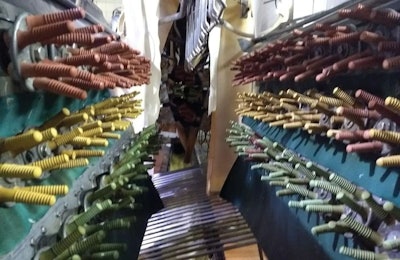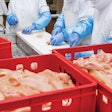
Consumers neither want to buy processed chickens with feathers still in place, nor with damaged skin, both of which can occur when plucking is not correctly carried out. To keep rejects and downgrades at the broiler processing plant to a minimum, several checks can be carried out in the various stages prior to plucking and during the plucking process itself.
Care must be taken during stunning to ensure that birds receive neither too much nor too little current.
It is worth remembering that a broiler’s tail and wing feathers arise from muscle tissue. Excess current at stunning will result in these muscles contracting and the follicle tightening, making removal of these feathers more difficult.
Bleed tunnel
Carcasses should not remain in the blood tunnel for in excess of 3.30 minutes as, beyond this, rigor mortis may set in. This increase in muscular contraction will similarly negatively affect feather removal.
Scalding
Carcasses must be properly immersed in the scalder. If birds remain at the surface of the scalding tank, the tail and wing feathers will remain above the water line, their follicles will not properly dilate and the feathers will not loosen.
Similarly, if there is uneven water turbulence in the scalding tank, and birds are not fully immersed, the same situation will arise with other feather follicles.
The heat that is absorbed by birds while in the scalding tank must be preserved as much as possible during transit to the first plucker as a failure to do so will result in the follicles starting to close.
Plucking
In addition to the particular difficulties presented by tail and wing feathers, you will need higher temperatures for remove effectively those feathers around the head and the cuticle that covers the thigh joint.
Removal of wing feathers can be aided by angling the plucker toward the exit, but too often processors choose to increase the pressure applied by the plucking fingers to remove wing weathers with the risk of carcass damage.
When the above steps are not properly followed, it is tempting overly adjust the plucking fingers, but care should be taken not to damage the skin or to dislocate bones, and too much adjustment can result in carcass damage.
It is also important to not allow shackled birds to build up at the entrance to the pluckers as this can result in carcass damage. The shackles should always be vertical, and this should be monitored pre- and post-plucking.
It is also worth ensuring that the upper guide rails of the shackles are not too far apart as this also can result in unwanted carcass movement and damage.
There should be no empty shackles, or shackles where birds are hung by one leg only, as both will have an impact on yield. In the case of the latter, either time will be lost hanging birds properly, or carcasses will suffer damage.
Correct alignment of the water nozzles that keep the plucking fingers clean is also important, so that fingers remain as clean as possible and feather removal is not impeded. Adequate water pressure — in many plants this is 25-30 psi — is also important, but water should not be wasted.
Due to the varying degree with which feathers are attached to the body, three gauges of plucking fingers are normally used: hard, semi-hard and soft.
Those in charge of the plant must understand the degree of firmness and flexibility of the fingers used as, despite firmness being internationally standardized, it can vary from supplier to supplier.
This means that a choice must be made as to which fingers will remove feathers the most efficiently while causing the least damage to carcass skin.
When birds are processed whole, this becomes even more important as, if fingers are very hard and come into close contact with the carcass, some skin may be removed, which many consumers do not like.
Alongside using fingers with the correct degree of firmness, the fingers need to be checked on a daily basis for splits or wear and missing fingers must be replaced.
Eduardo Cervantes López is an international consultant based in Colombia. He can be contacted at [email protected] or via www.icproave.com.















